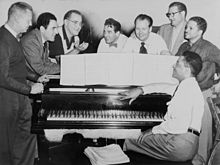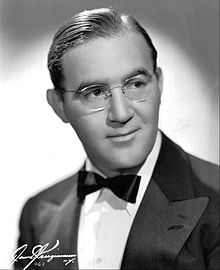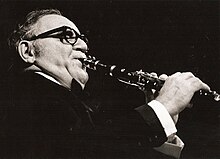Benny Goodman
Benjamin David "Benny" Goodman (born May 30, 1909 in Chicago , Illinois , † June 13, 1986 in New York City , New York ) was an American jazz musician ( clarinetist ) and band leader . Especially in the 1930s he celebrated great success with his big band and is considered one of the most popular protagonists of swing .
Live and act
Goodman was born in Chicago to poor Jewish immigrants . As a ten-year-old he received a clarinet and lessons in the Kehelah Jacob Synagogue. Franz Schoepp of the Chicago Symphony Orchestra taught him for two years . At the age of twelve he was already playing in the theater orchestra and in various dance bands in the city. During his high school years, he also performed with the Austin High School gang in 1922 . His jazz teachers were the great soloists and bands of the 1920s, u. a. King Olivers Creole Jazz Band with Louis Armstrong and the representatives of Chicago jazz . Goodman joined one of the leading bands in Chicago at the time, the Ben Pollack Orchestra, with which he toured and made his first recordings in 1926, including the first recording of a clarinet solo he played on December 17th (He's the Last Word) . Two years later he moved to New York City , where he worked for radio and as a session musician . a. for Ben Selvin and Paul Whiteman and as a theater musician on Broadway .
In January 1931 he had his first chart success with his record recording of the song He's Not Worth Your Tears (# 20). For the radio series Let's Dance, the clarinetist formed his first big band in 1934 in the Billy Rose's Music Hall club, which united white and black musicians for the first time in the history of jazz. With her perfection she gained recognition not only from jazz fans, but also from numerous music lovers outside of jazz, for example in Mozart concerts. The big breakthrough with the audience was denied for the time being. In the early 1930s he played with the nationally known bands of Red Nichols , Isham Jones and Ted Lewis .
From 1933 he had other hits for Columbia such as Fats Wallers Ain'tcha Glad (# 6) and the songs I Gotta Right to Sing the Blues (# 20) and I Ain't Lazy, I'm Just Dreaming (# 6), with Jack Teagarden as a band singer. In June 1934 he achieved the first of his sixteen number 1 hits with Moonglow . During this time, Glenn Miller also played as a freelance trombonist. It was not until 1935 in the Palomar Ballroom that he experienced the breakthrough with his own band and has now traveled from success to success.
On January 16, 1938, Goodman gave his famous jazz concert (see The Famous Carnegie Hall Concert 1938 ) in New York's Carnegie Hall . The concert was a resounding success, as a result of which jazz became socially acceptable almost overnight and also became increasingly accepted in the "finer circles". The inclusion of the concert, especially the long final title Sing, Sing, Sing , is today a milestone and an important genre classic and was accepted into the select circle of the Jazz Hall of Fame years ago .
From 1934 to 1938 Goodman recorded for the Victor label , which later traded under the name RCA Victor . From 1939 his records were released on Columbia Records , which also brought out Goodman's first concert at Carnegie Hall. He also recorded one of his greatest hits for Victor, Edgar Sampson's Don't Be That Way , which was number one for five weeks and stayed in the charts for 13 weeks. Besides Stompin 'at the Savoy , this was the number that Goodman had to play over and over for his audience.
In addition to his big band, which included star trumpeters Harry James and Ziggy Elman , he also founded the Benny Goodman Quartet , which united the jazz greats Teddy Wilson , Gene Krupa and Lionel Hampton . In this quartet, Teddy Wilson and Lionel Hampton, two black musicians played together with two white musicians, which was a taboo at the time .

The music of the band leader Benny Goodman was primarily aimed at highlighting him in his role as a soloist on the clarinet, although he always had other outstanding soloists and vocalists, such as Helen Ward , Peggy Lee or Ella Fitzgerald , in his band. Although Goodman was not an innovator in the rank of Duke Ellington or Count Basie , only relatively few of his pieces come from his own pen. The meticulous arrangements of his tracks, however, were mostly very catchy and so he was able to reach a larger audience than them with his virtuoso playing in the circle of perfectly well-rehearsed bandmates and certainly also because of the skin color. Stylistically, his music marked the mainstream of swing and together with Artie Shaw , who also played the clarinet, he was the most popular white bandleader of the swing era, who also enjoyed great success in the post-war period.
Many music critics today believe that Goodman has the same meaning for jazz and swing as Elvis Presley, for example, for rock 'n' roll . Benny Goodman had the goal of bringing "black" music closer to a young white audience, and he also did a great deal of work in overcoming racial segregation in the United States, because in the early 1930s black and white jazz musicians could play in most of them Do not play bands or concerts together because of public opinion . He made this possible in his own big band. This is one of the reasons why he is now considered the King of Swing alongside Fletcher Henderson .
Representatives of so-called " serious music " such as Paul Hindemith , Aaron Copland , Malcolm Arnold and Béla Bartók have dedicated compositions to him. Benny Goodman himself also played classical music, for example the clarinet concerto KV 622 and the clarinet quintet KV 581 by Wolfgang Amadeus Mozart .
Private life
Goodman was married to Alice Hammond Duckworth, sister of producer John Hammond , since 1942 ; the relationship has two daughters.
Movies
The musical film Sweet and Low-Down about and with Benny Goodman was released as early as 1944, but it is rather fictional.
The 1955 film The Benny Goodman Story was shot about Benny Goodman (director: Valentine Davies ), with Steve Allen in the title role. Goodman himself once said that the music was quite good, but the biography wasn't right. In 2011 the documentary Jazz für die Russen - To Russia with Jazz was released about Goodman's 1962 tour of the Soviet Union.
Discographic notes
Collections
- Classic Columbia and Okeh Benny Goodman Orchestra Session (1939–1958) - ( Mosaic , 2008) - 7 CDs with Ziggy Elman , Chris Griffin , Corky Cornelius , Vernon Brown , Toots Mondello , Jerry Jerome , Fletcher Henderson , Artie Bernstein , Nick Fatool , Charlie Christian , Johnny Guarnieri , Fred Astaire , Lionel Hampton , Cootie Williams , Lou McGarity , Georgie Auld , Mike Bryan , Cutty Cutshall , Bernie Leighton , Teddy Wilson , Hymie Schertzer , Count Basie , Dave Tough , Billy Butterfield , Jo Jones , Mel Powell , Sid Catlett , Vido Musso , Bernie Privin , Sid Weiss , Dave Barbour , Trummy Young , Aaron Sachs , Clyde Lombardi , Morey Feld , Slam Stewart , Bud Freeman , Johnny Best , Kai Winding , Stan Getz , Peanuts Hucko , Buddy Rich , Joe Bushkin , Zoot Sims , Barney Kessel , Bob Haggart , Johnny Smith , Paul Smith , George Van Eps , Mundell Lowe , Eddie Safranski , Don Lamond , Buck Clayton , Doc Severinsen , Hank Jones , George Duvivier
- The Complete Capitol Small Group Recordings of Benny Goodman 1944–1955 (Mosaic, 1994) - 6 LPs or 4 CDs with Teddy Wilson , Cozy Cole , Jess Stacy , Dave Barbour , Peggy Lee , Jimmy Rowles , Benny Carter , Charlie Shavers , Red Norvo , Irving Ashby , Red Callender , Don Lamond , Mel Powell , Louis Bellson , Wardell Gray , Fats Navarro , Mundell Lowe , Buddy Greco p & voc, Clyde Lombardi , George Duvivier , Jo Jones , Ruby Braff , Lionel Hampton
- Swing Swing Swing - Rare Recordings from the Yale University Music Library - (Limelight, 1993) 6 CDs, recorded 1955–1986 with Herb Geller , Jerry Dodgion , Ted Nash , Ken Peplowski , Flip Phillips , Paul Quinichette , Zoot Sims , Buddy Tate , Bob Wilber , Pepper Adams , Russ Freeman , Roland Hanna , Dave McKenna , Teddy Wilson , Billy Bauer , Chuck Wayne , Attila Zoller , George Duvivier , Milt Hinton , Arvell Shaw , Ruby Braff , Taft Jordan , Joe Newman , Randy Sandke , Dan Barrett , Vernon Brown , Buster Cooper , Urbie Green , Bill Harris , Red Norvo , Louie Bellson , Don Lamond , Shelly Manne , Bobby Donaldson , Ethel Ennis , Jimmy Rushing , Phil Woods , Teddy Edwards , Budd Johnson , John Bunch , Hank Jones , Pete Jolly , Kenny Burrell , Martha Tilton , Monty Budwig , Bill Crow , Jimmy Maxwell , Allen Smith , Joe Wilder , Jimmy Knepper , Mousey Alexander , Mel Lewis , Victor Feldman , Bobby Hackett , Steve Swallow
Works (excerpt)
Goodman was best known for his interpretations of foreign compositions. He participated in numerous compositions that he worked on together with the members of his bands - especially in the smaller ensembles. Particularly noteworthy are the musicians Lionel Hampton ( vibraphone ) and Charlie Christian ( electric guitar ). He is more rarely documented as the sole composer.
- AC - DC Current (Christian - Hampton - Goodman)
- Air-Mail Special (Mundy - Christian - Goodman)
- Don't Be That Way (Goodman - Sampson - Parrish)
- Flying Home (Goodman - Hampton - Robin)
- Opus 1/2 (Goodman - Hampton - Wilson - Tough)
- Opus 3/4 (Goodman - Hampton)
- Opus Local 802 (Goodman)
- Pick-A-Rib, Pts. 1-2 (Goodman)
- Seven Come Eleven (Goodman - Christian)
- Smoke House Rhythm (Goodman - Norman)
- Soft Winds (Goodman)
- Stompin 'at the Savoy (Goodman - Webb - Sampson - Razaf)
- Vibraphone Blues (Goodman - Hampton)
Honors
The software version 4.0 (September 2014) of WordPress was named "Benny" to honor the jazz clarinetist and band leader.
literature
- David Jessup: Benny Goodman. A Supplemental Discography . Scarecrow Press, Lanham / MD 2010, ISBN 978-0-8108-7685-9
-
James Lincoln Collier : Benny Goodman and the Swing Era. 1989.
- Benny Goodman, king of swing. Virtuoso reflection of an era. Hannibal, Vienna 1992, ISBN 3-85445-074-5 (with discography by Manfred Scheffner ).
- Arrigo Polillo : Jazz. Piper 1984 (Goodman Chapter).
- George T. Simon : The Big Bands. 1984 (with interview).
- Simon, George T .: The Big Bands . With a foreword by Frank Sinatra. 3rd revised edition. New York City, New York: Macmillan Publishing Co and London: Collier Macmillan Publishers, 1974, pp. 204-227 and Interview Benny Goodman Revisited pp. 524-528.
- Stanley Dance : The World of Swing. Da Capo Press, New York 1979, ISBN 0-306-80103-5 .
- Eddie Condon & Richard Gehman: Eddie Condon's Treasury of Jazz. 1956 (with Goodman's memories of his time in Chicago).
- Benny Goodman & Irving Kolodin: The Kingdom of Swing. 1939 (autobiography until 1938).
- My way to jazz. An autobiography. Sanssouci Verlag, Zurich 1961.
- Ross Firestone: Swing, Swing, Swing: The Life and Times of Benny Goodman. New York, Norton 1993.
- Donald Russell Connor: Benny Goodman - listen to his legacy. Scarecrow Press 1988 (updated in Benny Goodman - wrapping it up. 1996).
- Donald Russell Connor: Bg on the Record: A Bio-Discography of Benny Goodman. Arlington House 1978.
- Studs Terkel : giants of jazz. Zweiausendeins, Frankfurt 2005, ISBN 3-86150-723-4 .
Web links
- Benny Goodman in the Internet Movie Database (English)
- Literature by and about Benny Goodman in the catalog of the German National Library
- Official Website of Benny Goodman (English)
- Sound recordings with Benny Goodman in the Austrian Media Library
Individual evidence
- ^ Benny Goodman in the Find a Grave database . Retrieved July 15, 2014.
- ↑ In the opinion of drummer Gene Krupa, Goodman "built a band that played music for musicians, but he did nothing that was beyond the audience's horizon;" n. Kunzler Jazzlexikon
- ↑ WordPress 4.0 “Benny”. Retrieved September 8, 2014 .
| personal data | |
|---|---|
| SURNAME | Goodman, Benny |
| ALTERNATIVE NAMES | Goodman, Benjamin David |
| BRIEF DESCRIPTION | American jazz musician (clarinetist and band leader) |
| DATE OF BIRTH | May 30, 1909 |
| PLACE OF BIRTH | Chicago , Illinois |
| DATE OF DEATH | June 13, 1986 |
| Place of death | New York City , New York |


